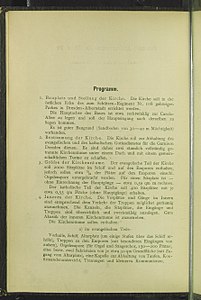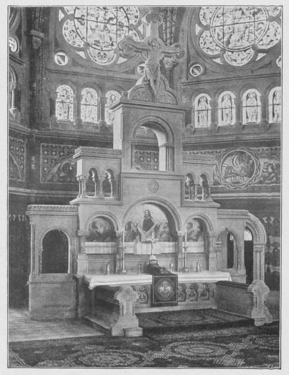Garrison Church of St. Martin
The Garrison Church of St. Martin (actually Simultankirche St. Martin ) in Dresden was the garrison church of Albertstadt , which was laid out as a military town for large parts of the Saxon army . The double church was built in the second construction phase between 1893 and 1900 in the central location of the barracks complex.
It was divided into two separate church rooms for the Protestant and Roman Catholic denominations , of which only the Catholic part has been used sacred since 1945. Since then, the simultaneous church of St. Martin has been the parish church of the St. Franziskus Xaverius congregation in Dresden-Neustadt .
location
The church is located on Stauffenbergallee (formerly Heeresstraße or Carolaallee) in the immediate vicinity of the central arsenal building, today's military history museum of the Bundeswehr . The entrances to the church are on the north side, facing Stauffenbergallee. This unusual arrangement made it easier for the mixed denominational troops to enter and gather.
The slightly enclosed valley of the Prießnitz runs to the east of the church ; the church itself is not only located opposite the Prießnitztal, but also slightly higher than the inner city of Dresden. To the south it towers over the Alaunpark , the green lung of the trendy district of Äußere Neustadt . Except for the south side, the garrison church is not surrounded by other buildings, but by a park and forest landscape.
architecture
The church is a building of historicism . In the external design, mainly elements of the Romanesque style have been incorporated. The surrounding buildings of the garrison are also predominantly historical, but are mainly based on the classicist style. The architects of the church were Hermann Viehweger and William Lossow , who is best known as the architect of Leipzig Central Station . The building material for the church is Cotta sandstone .
The garrison church is one of the last sacred buildings of historicism in Dresden. Just two years after the consecration, the Christ Church by Schilling & Graebner in Strehlen, one of the first churches of reform architecture, was started. William Lossow also took on stylistic elements of the counter-movement to historicism in later buildings.
The strict separation of the two parts of the church is not immediately apparent from the outside. The Simultankirche has a suggested nave in the shape of a cross, which is separated by a wall. The Catholic part is located in the eastern nave , the Protestant part occupies the indicated transept. In particular, the richly structured south facade suggests a longitudinal construction. The choirs in both parts face south and are therefore parallel. The evangelical room is the larger.
The church has only one steeple which , with its height of 90 meters and the height of the church, sets a landmark in Dresden. It is placed on the north facade between the two parts of the church. Originally, the tower carried six bells in two bell stalls built on top of each other. Three of the bells were removed during World War I. The empty iron belfry has been preserved. During the Second World War, two more bells were replaced by iron ones.
In and on the church there are around 900 columns with as many capitals , none of which are the same.
Here are excerpts from documents from the architectural competition:
- Program for the architectural competition of the Kgl. Saxon. Ministry of War (1893)
- Design drawings of the winning design "Saxon coat of arms" by the architects Lossow & Viehweger (1893)
history
After the founding of the German Empire, a military complex was built in Dresden in Albertstadt, initially for around 10,000 and later a little more soldiers from the Royal Saxon Army. This made it possible to replace the individual barracks that were previously scattered and converted by the city. The churches of the city continued to take over Christian pastoral care. Going back to the principle of " Cuius regio, eius religio " laid down in the Augsburg Religious Peace and the introduction of the Reformation in Saxony in 1539, Dresden was almost exclusively Protestant-Lutheran, so that until then, Catholic military members had used the only Catholic church in Dresden, the Catholic Court Church on Schlossplatz. The Dreikönigskirche on Hauptstrasse was responsible for evangelical support for the site . Albertstadt was financed primarily from reparations from France after the Franco-German War , and the bells of the church were also cast from the metal of captured cannons.
The office of William Lossow and Hermann Viehweger won the competition to build the church . For the simultaneous church, three foundation stones were laid on October 28, 1895, one each for the two parts of the church and a third for the tower as an expression of the fact that the tower does not belong to any part of the church. The church was consecrated on October 28, 1900. The building contains a gallery dedicated to King Albert I , but he only visited the church twice.
The church was not hit during the air raids on Dresden city center on February 13 and 14, 1945 . The rifle barracks in the immediate vicinity of the church received a severe hit and was not rebuilt. Both Albertstadt as a military target and the densely populated Äußere Neustadt in the vicinity of the church were not targeted by bombings in any attack on Dresden.
After the war the church lost its function as a garrison church. The Catholic St. Franziskus Xaverius Congregation, whose church on the main street in the Inner New Town was destroyed, found a replacement in the garrison church. The evangelical part was initially used by the parish of the destroyed St. Pauli Church , which, however, in the mid-1960s decided not to use the space that was much too large for it and set up parish rooms in the rectory.
In the post-war period, Albertstadt took on an important function as a storage and archive facility, also due to the destruction in the city center. Accessible parts of state institutions such as the state library and art collections were located in the garrison buildings . The phonotheque of the library was located in the evangelical part of the garrison church. With the reopening of the museum and exhibition buildings, Albertstadt gave up these tasks over the decades. Since 2002 the Phonothek has been located in the main building of the new Saxon State Library - State and University Library .
With the opening of the Albertstadt barracks in 1998, in which the army officers' school is located, the catholic part of the garrison church was used again for services of the military chaplaincy, both catholic and evangelical.
In the same year, the garrison church, which had been run as a federal property since 1990, was sold to a private investor together with the surrounding property. The rights of use remain unaffected. Part of the building serves as a depot for the Dresden Puppet Theater Collection .
- View of the former Protestant part (approx. 1906)
organ
The organ in the catholic part of the garrison church was built in 1900 by the Dresden organ building company Gebrüder Jehmlich . It was connected to the Jehmlich organ in the Protestant part of the garrison church; both instruments had a common wind turbine . 2003 to 2004 the instrument was restored by the builder company. It has 21 stops on two manuals and a pedal .
|
|
|
||||||||||||||||||||||||||||||||||||||||||||||||||||||||||||||||||||||||
- Coupling : II / I, I / P, II / P
- Playing aids : Octave coupler, fixed combinations (Fortissimo, Forte, Mezzoforte), crescendo roller
Organists
Web links
Individual evidence
- ^ German competitions; Volume III, issue 1 and 2 (No. 25 and 26), 1894 SLUB Dresden
- ↑ Day of the Lord 48 (1998), Issue 38, accessed June 3, 2011
Coordinates: 51 ° 4 ′ 28.6 " N , 13 ° 45 ′ 34.3" E



















